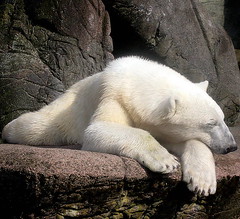Polar Bears and Bayesian Networks
Bayesian networks are also used within ecology and management of natural resources. Yesterday, I found a new example of this. In a recent news item in Nature, US decision on polar bear status on hold, it was described how Bayesian networks have been used to give answer to the following:
In January 2007, the wildlife service asked the US Geological Survey to address three questions: How much ice is melting, how fast is it melting, and how will this affect polar bears?
As a Dane, I have a special interest in polar bears. Denmark and Norway have had a tight connection with Greenland ever since the Erik the Red and Greenland is now a self-governing Danish province. Stories about polar bears are common in Danish litterature. To name a few: I still remember Little Nanok a childrens book by Elmar Drastrup, about the troublesome life of a polar bear cub, and Jørn Riel has written some excellent collections of 'tall' stories from Greenland. Some of them seems to have been translated at least into French and German.
In addition, a standard urban myth(?) describes how foreigners believe that polar bears roam the streets of Copenhagen. The story is actually used as the opening lines in
But this has very little to do with Bayesian Networks
So I will return my focus with another quote from the Nature article:
Answering those seemingly simple questions [quoted above] was a challenge, not only because the future climate is difficult to predict, but also because data on the bears is so meagre. Little is known about the bears that live in the most remote regions, such as the Arctic basin at the very top of the world. Among the 19 subpopulations found throughout the Arctic, there are three whose numbers have never been counted and are unknown.
"The goal was to try and extract the maximum amount of information from the data that we do have," says Steven Amstrup, who leads the polar bear research group at the US Geological Survey in Anchorage, Alaska.
Amstrup and colleagues have assessed the effects of individual stressors, such as hunting and ice loss, and used a ‘Bayesian network model’ to estimate the likelihood of different outcomes to the stressors. They found that declining sea ice overrode all other factors, and that several populations of polar bears, including those found along the southern Beaufort Sea, north of Alaska, were likely to vanish by the end of this century.
A very detailed description of the network can be found in the report Forecasting the Range-wide Status of Polar Bears at Selected Times in the 21st century.(pdf-file) by Steven C. Amstrup, Bruce G. Marcot, and David C. Douglas.
The Bayesian Network models how different stressors influence the polar bear population and the network was based on expert-input from S. Amstrup concerning the model structure and the relevant tables of conditional probabilities. The nodes of the network were divided into three kinds. 1) the input nodes representing anthropogenic stressors and environmental variables. 2) Summary nodes combining the efects of the different stressor, and 3) the output nodes, i.e., nodes describng the effect on population size and structure. The figure shown below is a copy of Figure 4 in the report. The figure illustrates the relation between the nodes in network

My search for further information concerning the research led me to this page concerning Bayesian Network Models in Ecology by one of the authors of the report, Bruce G. Marcot. He was the knowledge engineer in the study. The home page includes several interesting links
Amstrup and other -trups
I started on the irrelevant mood, and this final section is to maintain the symmetry. I am almost certain that Steven Amstrup is a descendant of Danish emmigrants. Amstrup is the name of at least 3 Danish villages, and follows a standard construction of Danish village names, which was very common in Denmark just in the period following the viking age. The construction is: name plus -strup/torp/-rup. The original ending


No comments:
Post a Comment